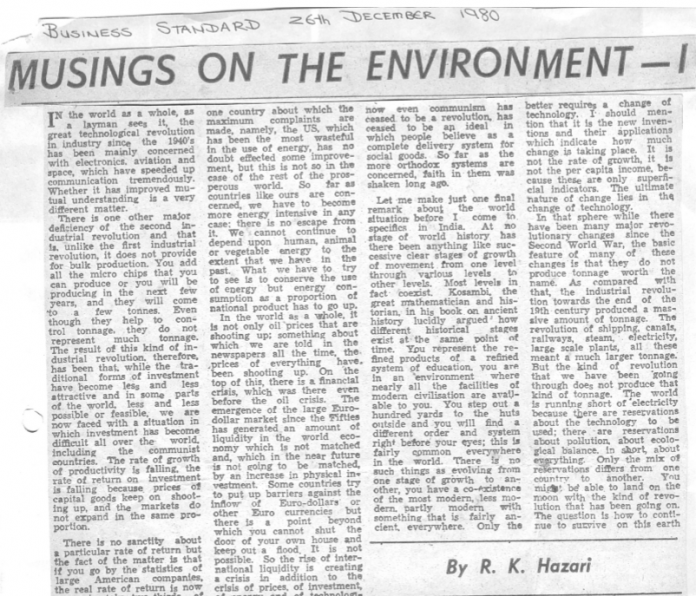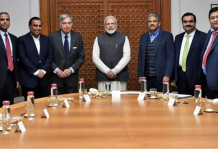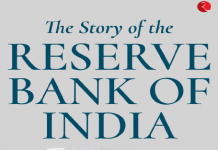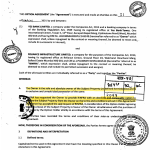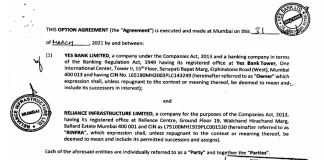In the world as a whole, as a layman sees it, the great technological revolution in industry since the 1940’s has been mainly concerned with electronics, aviation and space, which have speeded up communication tremendously. Whether it has improved mutual understanding is a very different matter.
There is one other major deficiency of the second industrial revolution and that is unlike the first industrial revolution, it does not provide for bulk production. You add all the micro chips that you can produce or you will be producing in the next few years, and they will come to a few tonnes. Even though they help to control tonnage, they do not represent much tonnage. The result of this kind of industrial revolution, therefore, has been that, while the traditional forms of investment have become less and less attractive and in some parts of the world, less and less possible or feasible, we are now faced with a situation in which investment has become difficult all over the world, including the communist countries. The rate of growth of productivity is falling, the rate of return on investment is falling because, prices of capital goods keep on shooting up, and the markets do not expand in the same proportion.
There is no sanctity about a particular rate of return but the fact of the matter is that if you go by the statistics of large American companies, the real rate of return is now approximately two-thirds of what it used to be in the mid-6O’s which was probably a rather high level, but It had gone down even -more and has tended to recover somewhat only lately. We do not have equivalent statistics for Russia, but from what one hears, or from what one can make out between the lines, there are complaints about the falling rate of return even in the USSR. It is true even in India : the real rate of return, that is, the financial rate of return deflated for price increases, has been falling for some years.
It is not worthwhile to say that Marx had predicted all this, because even assuming that Marx had predicted it, that does not make us any wiser about what exactly to do about it. Even before the energy crisis hit the world, there was a very genuine economic crisis that was brewing. The actions of the oil producers only made the situation worse. The energy crisis all over the world is a very genuine crisis, all the more genuine because very little has been done about it Strangely enough, between 1974 and 1978, that is, between the first round of price increases in oil and before the latest round of price increases took place, there was actually a 10 per cent decline in the real price of oil that is, non-oil prices rose more than the price of oil. If you take the OECD countries, that is, all the prosperous countries including Japan, there has been little or no net saving of energy. The one country about which the maximum complaints are made, namely, the US, which has been the most wasteful in the use of energy, has no doubt effected some improvement, but this is not so in the case of the rest of the prosperous world. So far as countries like ours are concerned, we have to become more energy intensive in any case: there is no escape from it. We cannot continue to depend upon human, animal or vegetable energy to the extent that we have in the past. What we have to try to see is to conserve the use of energy but energy consumption as a proportion of national product has to go up.
In the world as a whole, it is not only oil prices that are shooting up; something about which we are told in the newspapers all the time, the, prices of everything have, been shooting up. On the top of this, there is a financial crisis, which was there even before the oil crisis. The emergence of the large Euro dollar market since the Fifties has generated an amount of liquidity in the world economy which is not matched and, which in the near future is not going to be matched, by an increase in physical investment. Some countries try to put up barriers against the inflow of Euro-dollars or other Euro currencies but there is a point beyond which you cannot shut the door of your own house and keep out a flood. It is not possible. So the rise of international liquidity is creating a crisis in addition to the crisis of prices, of investment, of energy and of technological trends.
At the same time, for better or for worse, there is a worldwide decline or disintegration of ideology as well as religion. I am one of those who beliefs that people live not only by bread and jam, if they can get it but in addition, in spite of all appeals to logic, one needs some anchorage of faith. What an anchor is to a ship, religion or ideology is to a society. In the communist countries there is a visible decline of faith in the viability of communist doctrine. In the rest of the world, there is a visible decline or disintegration of faith in every political order or church or any of their equivalents. ‘ People doubt what they see around, they do not feel that they are living in a system that is viable or justifiable and which, therefore, deserves their homage or loyalty.
What inspires people to work for the remote future instead of for the immediate present? The feeling that you are bringing the future to birth today. You believe that the doctrine which you are propagating is viable, justifiable in one form or another and that the future lies with you. This is how Islam spread far and wide within 5O years of the death of Mohammed. This is how Christianity and Buddhism spread, though over a much longer period of time In a way communism was also spreading like this at one time. But now even communism has ceased, to be a revolution, has ceased to be an ideal in which people believe as a complete delivery system for social goods. So far as the more orthodox systems are concerned, faith in them was shaken long ago.
Let me make just one final remark about the world situation before I come to specifics in India. At no stage of world history has there been anything like successive clear stages of growth of movement from one level through various levels to other levels. Most levels in fact co-exist Kosambi the great mathematician and historian, in his book on ancient history lucidly argued how different historical stages exist at-the same point of time. You represent the refined products of a refined system of education, you are in an environment where nearly all the facilities of modern civilisation are available to you. You step out a hundred yards to the huts outside and you will find a different order and system right before your eyes; this is fairly common everywhere in the world. There is no such things as evolving from one stage of growth to another, you have a co-existence of the most modern, less modern, partly modern with something that is fairly ancient, everywhere. Only the proportions are mixed and they differ from time to time, place to-place, from society to society. What you call a more modern society has more of the modern things coexisting and less of the ancient ones, while In a relatively poor and so-called backward society like ours we have many more of the ancient things.
Progress has always been and has to be judged ultimately by change of technology. When the Mohenja-daro and Harappa seals are deciphered, we shall come to know how these great civilisations suddenly disintegrated. One of the revealing things about them was that they built a new city after every major flood but the houses exactly reproduced the previous construction, going by the archaeological evidence. These two cities are believed to have flourished for about 1500 years from 3000 B.C. to about 1500 B.C. when they were destroyed. For 1,500 years, they had no change of technology though, in some matters, they were very advanced, their city planning was extremely good, the system of grain storage were obviously extremely good and their priests and traders were obviously very much in control. Similarly, the wooden plough which most of our farmers use has not changed for a thousand years or more. While many social changes are necessary, I am sufficiently materialistic ‘ to believe that change for the better requires a change of technology. I should mention that it is the new inventions and their applications which indicate how much change is taking place. It is not the rate of growth, it is not the per capita income, because these are only superficial indicators. The ultimate nature of change lies in the, change of technology.
In that sphere while there have been many major revolutionary changes since the Second World War, the basic feature of many of these changes is that they do not produce tonnage worth the name. As compared with that, the industrial revolution towards the end of the 19th century produced a massive amount of tonnage. The revolution of shipping, canals, railways, steam, electricity, large scale plants, all these meant a much larger tonnage. But the kind of revolution that we have been going through does not produce that kind of tonnage. The world is running short of electricity because there are reservations about the technology to be used; there are reservations about pollution, about ecological balance. In short, about everything. Only the mix of reservations differs from one country to another. You might be able to land on the moon with the kind of revolution that has been going on. The question is how to continue to survive on this earth because, in the absence of adequate tonnage, you do not provide adequate opportunities for employment, nor do you provide adequate opportunities for outflow of financial liquidity into physical investment.
Coming to India, there are two basic features that I might start with both of which are unfavourable but since I am going to say something that is intrinsically favourable about the Indian economv — and I still 1ike to be optimistic about the Indian political situation — I should start with the unfavourable elements first.
Whether the Government officially recognises it or not, we have had a Plan holiday since 1962, the year we went to war with China. We have not really resumed planning since then. I am not one of those who believe that planning of the sort that we have done in the past is absolutely essential. For certain crucial sectors of the economy, however, you need the drawing up of the contours over a sufficiently long period of time. If you have to do anything in the basic sectors of coal, steel, electricity, water and railways, you require not just a five-vear outlook, you require a 15 to 30-year outlook. That certainly requires advance planning, whether you do it in the style that we have done in the past or you do it in any other style. Whether you plan any thing else or not, these are the crucial sectors in which you have to plan.
Besides, in any systems view, these sectors do not exist by themselves, they are interconnected with health, education, balance of payments, ideas about choice of technology. Therefore, you do require a framework of planning, whether you have one system of planning or another, whether you call it a rolling plan or a perspective plan. You play about with figures, you do whatever you like, but there has to be a systems view of the crucial sectors of the economy. In this sphere, too, I am afraid, we have had a holiday for the last 18 years and this is fullv reflected in our rates of growth. The growth that has been taking place in India is based largely upon the momentum built till 1962—and the work done in agriculture, to which I will come in a moment.
The second unfavourable factor which is of immediate relevance is the fact that the ratio of increment investment to output has been going up steeply. It was expected during the First Plan period that you would require Rs. 2.80 to Rs. 3 of investment to produce one unit of output or income. Many things have been said since then, many capabilities have been built up, many huge plants have come up, some of them became sick and obsolete before they could be utilised vigorously, but as of now, due to a variety of reasons, which you probably know better than I do, the actual ratio has been deteriorating and has recently been close to 5 ½ to 6. If it takes you twice the amount of investment to produce a given amount of output, you are obviously inefficient, in spite of having the third largest stock of technical and scientific manpower in the world.
A lot of things are said about our educational system, but you are products of that educational system and so am I. I have no reason to be ashamed of the education that I have received, or which I have imparted, in turn for many years. On the whole our educational system is fairly good, it is respected outside the country. A large part of our export of manpower is based upon our educational system. Nevertheless, we take twice the amount of time if not more, than we should in completing an investment. This is reflected finally in the efficiency of the turnover of resources. The secret of good management and good investment is to be able to turn over the assets as quickly as possible. Whether you take working capital only or you take fixed capital only, or you take both, the turnover of capital is one of the best indicators that one can have of efficiency of management. Judged by that we have done extremely poorly.
On the other hand, let us see the positive side. In agriculture, the green revolution, which was at one time confined to wheat and that also in Punjab, Haryana and neighbouring Western U.P., has spread to many areas right up to Bengal. Even Bihar and Bengal are now large producers of wheat. Besides, there has been a genuine green revolution in rice also. There is a second and third crop of rice In Bengal and much higher yields of rice in Tamil Nadu, Andhra and also in Punjab and Haryana.
The extent of agricultural change in West Bengal is in fact, most remarkable, which most people have not noticed. If there is greater order in West Bengal today than in most of the other States, it if not because of a particular brand or Government, it is because there has been a massive agricultural change in at least half of its districts. It has been achieved by much better extension, both official and spontaneous. Midnapore, for example, was a very poor district even by Bengal standards, but it has prospered immensely during the last few years. It is a large producer of rice, wheat and maize. I could multiply the examples from a number of districts, even in Eastern U.P.
I would not go wholly by one figure, namely, larger output because output figures can always be manipulated. There is a large increase in the area under various forms of irrigation. There is a large increase in fertiliser consumption and there is a large increase in the sales of consumer products of certain well known companies. This is positive proof that there has been a large increase in the income and output of those districts. Maybe it is still unequally distributed but it is there. If there is a change in UP and Bihar, one can rest assured that the country is moving on the right lines because, between them, these two States determine the future and fate of this country. Unfortunately, they have lagged behind very much.
What is lacking In the green revolution first, in terms of area, is that there are two territories where there has been almost no change in agriculture. One is the north-east, which happens to bn in the newspapers for superficially different set of reasons, but this is one of the real reasons. If you have trouble in Assam it is largely because agriculture has not changed. The second is Orissa which is abundantly endowed with electricity, it has a fairly good civil service, but I would anticipate trouble in Orissa any day. It is somewhat better placed though than Assam. In terms of crops, the green revolution has not covered millets as yet and it has not made any impact on cattle-feed. I am not one of those who warship the holy cow, but I believe that the cow should be fed properly and we don’t do it. From the economic point of view, the cow Is a much better milk yielder than the buffalo which is very expensive. Nearly all our surplus milk, nevertheless, comes from buffaloes, not from cows, and if we have to have a programme on improvement of cows, it would be necessary to have a green revolution in millets and different kinds of cattlefeed.
Rise in rural tension
For every benefit there Is a cost. One has to see what the net total is. With this growth there has been inevitably a considerable increase in rural tensions. It is perhaps not true that the poor have become poorer but it is certainly true that our rich have become richer. Let us assume that a small farmer or rural labourer does get some benefit from the green revolution. At best he will eat a little more; he will still not become a surplus farmer. In the case of the larger farmers, it is the surplus that will increase since they cannot eat much more, even if some of them look as if they do. Wherever there is a green revolution, there is multiple cropping, that is, you not only get higher yields from the first crop but you get a second and a third crop, which means that the number of man days of employment Increases. The wage rates may or may not increase in some areas they have, in some others they have not—but the number of man days of employment during the year Increase and that should be the real purpose of rural development When rural labour acquires a certain standing and a certain value, human relations acquire different dimentions. What you hear about the new acute tensions arising between different sections of society has been made possible by the green revolution.
If today you hear so much about rape, molestation of women, it is largely because these things are noticed and objected to. For hundreds of years women of the poorer and lower castes have been considered natural objects of desire of the richer classes and landowning castes. What was considered tolerable or traditional so far is not tolerated any more; nor is the news suppressed. Certain castes have taken more readily than others to improved cultivation: for instance, in the same village, you will find Rajputs have not done it the Jats have. You will find similar distinctions in other States.
Those who have profited from the green revolution and seized the opportunities want their place in the sun, economically and politically; they are also more explicit and assertive In terms of their desires for women and for education. Like any other newly rich group their status and manners are looked upon with some distaste and disfavour by the rest of society, especially those of us from the urban areas who have held power somewhat earlier. Fortunately or unfortunately in India, caste and class can become readily identified with each other, so the conflicts can be sharper and wider. To some people, this is evidence of dis-integration. I regard it as one of the inevitable costs of progress. The positive function of conflict and competition is to disturb the old equilibrium and help bring about a new equilibrium. Meanwhile, one does get disequilibrium, even disorder. It is a test of the skills of political leadership to take society through this difficult path.
Let me for a short while go into a field which is professionally not mine but which I have adopted lately. I have turned to history. I am one of those who believe that Eastern India was never really Aryanised or Brahminised. It was the centre of Buddhism and Jainism to begin with, it was not really under Brahmin control, and that is why Varanasi became the holiest city of the Hindus-it represented the boundary of Hindudom proper. Beyond it. if you go by some of the ancient texts, when you went east of Varanasi, you had to perform the last rites before setting out and your purification after coming back. The relevance of what I am writing just now is that unlike South India, Eastern India has still to be integrated into the mainstream concept of India. A conscious effort is required to bring the Eastern territories into the mainstream of national life. Unfortunately, during the last 30 years or so, we have been much more concerned about South India because of the DMK agitation or because South Indians have been identified in our ancient scriptures as having been conquered by the Aryans. The eastern areas have also been a racial melting pot. There has been a constant influx of mongoloid tribes into the north east. Assimilation of all these elements has to be not in terms of passing laws, or parading of obscurantist Hinduism as a solution to all problems. You have to give people a vision of the future in which they can play an important role. Please remember, it was not a Greek who became the famous Greek of all, it was a Macedonian called Alexander. The greatest Romans were hardly Roman or not at all; they were people from outside Rome. You have to give people a stake in the future of the country. Eastern and North Eastern India have lagged behind the most, they have some of the poorest territories and the worst communications. Unless they are accommodated into the mainstream of national life I would anticipate danger to the country from within. I think there has been a general agricultural change In Bihar and Bengal not withstanding all the problems that one hears. I hope that even In Orissa there would be such a change in the near future. In the North East I regret to say I do not see as much evidence of change, or even as much sense of direction. If half of the money that has been spent on the police forces in the North East had been spent productively, there would have been a railway system there by now.
Let me come back to the last point in agriculture before I go on to industry. I think that we should emerge as large agrarian exporters in the near future. A lot of people are just now very concerned about the balance of payments; our foreign exchange reserves are going down. These are the swings of the pendulum There was a time when we were very worried about the foreign exchange reserves going up. We did not know what to do with them. We have misutilised part of them, a large part is gone away into oil imports. Now we are getting terribly worried because they are going down. I do not share that panicky view. This country can easily export about 2 to 3 million tonnes of foodgrains every year. The greatest positive factor that should bring to your notice is that this year was the worst drought of the century and we have survived it with no food imports and a left-over stock of 15 million tonnes of food. A large surplus rice crop will be coming to the market very soon.
In Industry and electricity people talk very naturally and very rightly of the emergence of unutilised capacity, of breakdowns in electricity or breakdowns in railways. My question on the other hand—and I am not being facetious—is : how and why, in spite of all our problems, are some things working In industry, in coal mines and in electricity and railways ? If we take all the factors into account, add up all the known problems and weaknesses it is a matter of surprise that we are at least getting what we are getting. There has been a total breakdown of discipline in the coal mining Industry for a long time. There has been total breakdown in the power sector in many States. Last year was an extremely bad one for hydro electricity. The generation of electricity in a crucial area, namely, the Damodar Valley Corporation, has been nominal. In the railways we are not Investing enough even to make up for the physical depreciation of the wagons, coaches, tracks, signaling, etc. If in spite of all that most things are functioning, it is a great achievement
We have gone through the worst already. Coal will not be any worse than it has been; it is likely to be better after the monsoon and the link-up of power transmission between U.P. and Bihar. There is already an improvement in hydro power. The physical requirement of oil is unlikely to be larger than witnessed this year because of better availability of power and coal. Also, oil prices are more or less stabilising now. This year, with the swing of the weather pendulum, you cannot help having a growth of national income of 6 to 8 per cent. Next year the present Government will naturally claim the credit for it. It will talk about foresight, competence, etc., when there is actually nothing of the kind.

